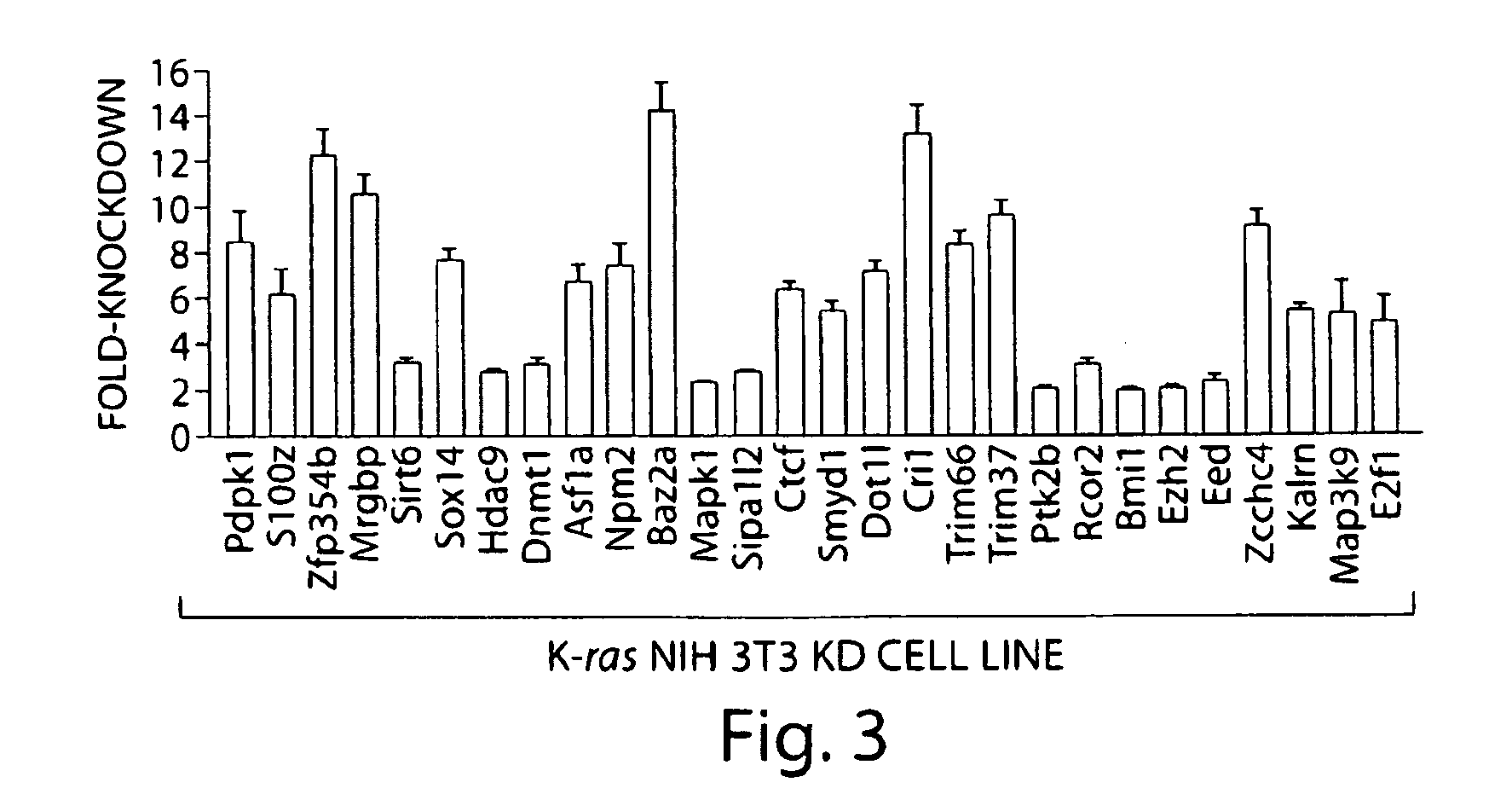Ras-mediated epigenetic silencing effectors and uses thereof
a technology of epigenetic silencing effectors and effectors, which is applied in the field of ras-mediated epigenetic silencing effectors, can solve the problems of loss of fas promoter hypermethylation, failure to recruit dnmt1 to the fas promoter, and de-repression of fas expression, so as to inhibit fas gene silencing in a cell
- Summary
- Abstract
- Description
- Claims
- Application Information
AI Technical Summary
Benefits of technology
Problems solved by technology
Method used
Image
Examples
example 1
RNAi Screen
[0078]Members of the ras oncogene family transform most immortalized cell lines, and mutations of ras genes occur in ˜30% of human tumours (Giehl, K, Biol. Chem. 386, 193-205 (2005)). In addition, activation of the Ras pathway is frequent in human tumours even in the absence of ras mutations (Ehmann, F. et al., Leuk. Lymphoma 47, 1387-1391 (2006)). Previous studies have shown that in mouse NIH 3T3 cells activated Ras epigenetically silences Fas expression thereby preventing Fas-ligand induced apoptosis (Fenton, R. G., Hixon, J. A., Wright, P. W., Brooks, A. D. & Sayers, T. J., Cancer Res. 58, 3391-3400 (1998); Peli, J. et al., EMBO J. 18, 1824-1831 (1999)). Activated Ras also epigenetically silences Fas expression in the human K-ras transformed cell line, HEC1A (FIG. 1). In addition, epigenetic silencing of Fas occurs in some transformed cells, human tumours, and mouse models of cancer, and this silencing is relevant to tumour progression (Hopkins-Donaldson, S. et al., Ce...
example 2
Hit Identification and Validation
Ras epigenetic silencing effectors (RESEs)
[0080]The screen identified 28 genes that, following shRNA-mediated knockdown, resulted in Fas re-expression. These genes are listed in Tables 1 and 2 and immunoblot analysis of Fas re-expression in the 28 K-ras NIH 3T3 knockdown (K-ras NIH 3T3 KD) cell lines is shown in FIG. 2b. Consistent with previous reports (Peli, J. et al., EMBO J. 18, 1824-1831 (1999)), treatment of K-ras NIH 3T3 cells with the DNA methylation inhibitor 5-aza-2′-deoxycytidine (5-aza) restored Fas expression (see also FIG. 1). Quantitative real-time RT-PCR (qRT-PCR) confirmed in all cases that expression of the target gene was decreased in each K-ras NIH 3T3 KD cell line (FIG. 3). For all 28 genes, a second, unrelated shRNA directed against the same target also resulted in Fas re-expression when stably expressed in K-ras NIH 3T3 cells (FIG. 4). Knockdown of each of these 28 genes in an additional cell line, H-ras transformed murine C3H1...
example 3
RESE Expression Analysis
[0083]A number of RESEs were substantially upregulated at the transcriptional (FIG. 6) or post-transcriptional (FIG. 7) level in K-ras NIH 3T3 cells compared to NIH 3T3 cells, explaining, at least in part, how K-ras activates this silencing pathway. One of the genes we found transcriptionally upregulated in K-ras NIH 3T3 cells was Dnmt1 (FIG. 6); consistent with our results, it has been previously reported that Dnmt1 is upregulated in K-ras transformed rat intestinal epithelial (RIE-1) cells (Pruitt, K. et al., J. Biol. Chem. 280, 23363-23370 (2005)) and in oncogenic Ha-ras-transfected adrenocortical tumour cells (MacLeod, A. R., Rouleau, J. & Szyf, M., J. Biol. Chem. 270, 11327-11337 (1995)).
PUM
| Property | Measurement | Unit |
|---|---|---|
| Digital information | aaaaa | aaaaa |
| Digital information | aaaaa | aaaaa |
| Electrical resistance | aaaaa | aaaaa |
Abstract
Description
Claims
Application Information
 Login to View More
Login to View More - R&D
- Intellectual Property
- Life Sciences
- Materials
- Tech Scout
- Unparalleled Data Quality
- Higher Quality Content
- 60% Fewer Hallucinations
Browse by: Latest US Patents, China's latest patents, Technical Efficacy Thesaurus, Application Domain, Technology Topic, Popular Technical Reports.
© 2025 PatSnap. All rights reserved.Legal|Privacy policy|Modern Slavery Act Transparency Statement|Sitemap|About US| Contact US: help@patsnap.com



